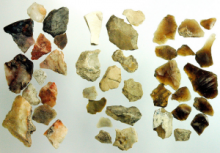Article
The waste product of stone work that involves chipping away at a core of hard rock. People in cultural groups around the world have developed stone-working techniques to produce tools such as sharp-edged knives, arrowheads, lance points, and bifaces (two-faced stone blades). To produce such tools, the core is held in one hand while the other hand holds a hammerstone (either another stone or an antler tine). The hammerstone is struck against the core at a specific angle in order to gradually break off chips of stone in the process of creating the desired shape of the tool. A chip, also known as a flake, is a small, long, and often thin piece of stone detached from the larger core of rock. The chipping process requires skill, experience, precision, and exact knowledge of the force and angle of the blow required to properly detach a chip. In this manner, stone tools can be produced from cores, often resulting in a large number of chips as waste products. In archaeological sites, chips can be classified by morphology (shape) and provide insights into what tools were produced.
In addition, chips can either be discarded as waste or used as tools themselves. For instance, chips with sharp edges can be used as cutting tools. In the American Southwest, chips were often used as blanks for arrowhead production.
"Chipped stone flakes from the Slininger Mound archaeological site (21-NR-1) in Norman County, Minnesota." by Brian Hoffman is licensed under CC BY-NC-SA.
Manuscripts
A04 Dance Hall of the Dead (04-06) p. 12
A04 Dance Hall of the Dead (04-06) p. 27
A04 Dance Hall of the Dead (04-06) p. 29
A04 Dance Hall of the Dead (04-06) p. 31
A04 Dance Hall of the Dead (04-06) p. 33
A04 Dance Hall of the Dead (04-06) p. 34
A04 Dance Hall of the Dead (04-06) p. 38
A04 Dance Hall of the Dead (04-06) p. 57
A04 Dance Hall of the Dead (04-06) p. 73
A04 Dance Hall of the Dead (04-06) p. 74
A04 Dance Hall of the Dead (04-06) p. 76
A04 Dance Hall of the Dead (04-06) p. 102
A04 Dance Hall of the Dead (04-06) p. 122
References
Andrefsky, William Jr.
1998 Lithics: Macroscopic Approaches to Analysis Cambridge Manuals in Archaeology.
Cambridge University Press: Cambridge England.

